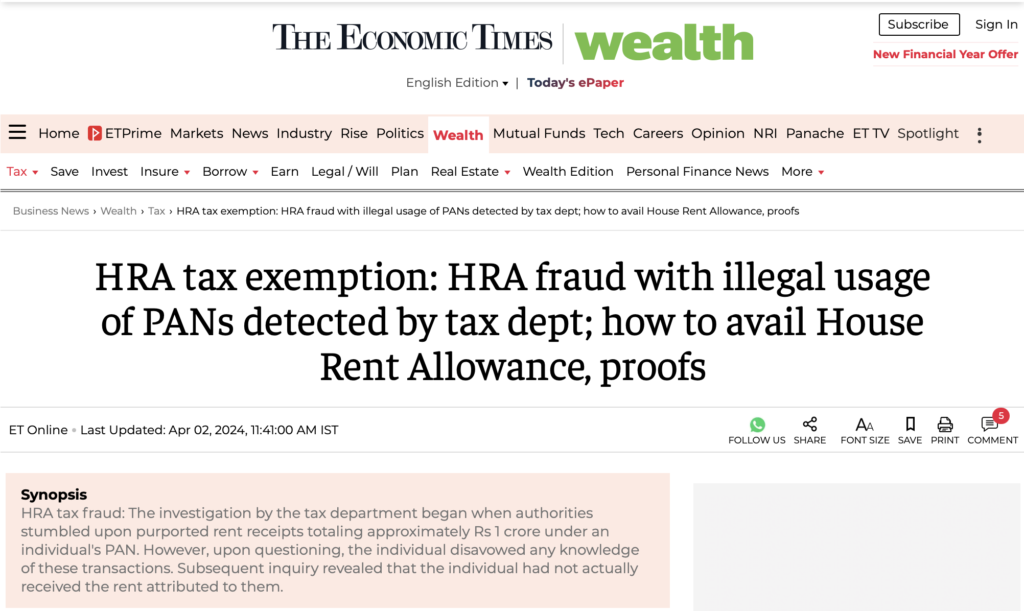Synopsis :- According to a report, the Income Tax Department has identified between 8,000 and 10,000 instances where employees have reportedly utilised unauthorised PANs to claim HRA deductions exceeding ₹10 lakh. Tax authorities have stated that penalties will be imposed solely on the employees involved in these violations. They clarified that employers will not be held responsible if employees submit fraudulent rent receipts.
The misuse of Permanent Account Numbers (PAN) for fraudulent House Rent Allowance (HRA) claims has become a significant issue, prompting the Central Board of Direct Taxes (CBDT) to issue comprehensive guidelines. The CBDT circular aims to curtail tax evasion by ensuring stricter verification of PAN details submitted for HRA exemptions. This initiative also aligns with judicial decisions that underscore the legal implications of using incorrect PAN information to claim tax benefits.
Recent court rulings have highlighted several cases where employees were penalized for submitting fraudulent PAN details to inflate or falsify HRA claims. These decisions reinforce the need for adherence to tax laws and provide a clear deterrent against the misuse of PAN.
Tax professionals and employees must stay informed about these regulations to avoid legal repercussions. By adhering to the CBDT guidelines, taxpayers can ensure their HRA claims are legitimate and compliant with tax regulations.
When exploring case laws related to the misuse of House Rent Allowance (HRA) claims in India, there are a few significant judgments that highlight the judicial approach to fraudulent HRA claims.
One pivotal case is Abhay Kumar Mittal v. DCIT-2022, where the issue centered on the validity of HRA claims when rent is paid to a spouse. In this case, the Income Tax Appellate Tribunal (ITAT) allowed the HRA claim because the assessee could substantiate that the house was purchased with a loan he provided to his wife, who then repaid it through legitimate means. The rent payments were acknowledged in tax filings and accepted by the revenue authority, affirming the legality of the HRA claim under such circumstances.
Another noteworthy case is Bajrang Prasad Ram Dharani V/s ACIT, Ahmedabad, 2013. This case also involved HRA exemption for rent paid to a spouse. The tribunal supported the exemption as the assessee demonstrated that he occupied the house owned by his wife and paid the rent through bank transfers, fulfilling the legal requirements for such claims.
These cases reflect the intricate scrutiny involved in HRA exemption claims, particularly concerning the authenticity of transactions between close relatives. They emphasize the necessity of maintaining proper documentation and proof of financial transactions to support the legitimacy of HRA claims.
Understanding these legal precedents can help employees and tax professionals ensure that their HRA claims are compliant with tax laws and upheld in legal challenges. For a deeper dive into the details and implications of these rulings, reviewing the full judgments and related discussions on tax forums or legal databases would provide a more comprehensive perspective.
Here are several relevant and important judicial decisions regarding claims of House Rent Allowance (HRA) under Section 10(13A) of the Income Tax Act, 1961, which provide insight into the handling of HRA exemptions in India:
1. Om Prakash Gattani vs. ITO (2000): In this case, the tribunal ruled that if an assessee lives in rented premises despite owning a house in another location, the claim for HRA exemption is justified as long as the employment needs necessitate living at the rented location.
2. ITO vs. Nikhil Gutgutia (Kolkata ITAT 2011): This case highlighted that HRA claims could be accepted even if the rent is paid to a spouse, provided there is a valid rent agreement and rent receipts are maintained to prove the transactions are genuine.
3. Sunil Kumar Agarwal vs. CIT (Kolkata High Court 2001): The court held that mere payment of rent to parents isn’t sufficient for claiming HRA unless it is clearly demonstrated that the arrangement isn’t a mere tax-saving gimmick. Documentation proving the genuine nature of the transaction is essential.
4. Vinay Mishra vs. Union of India (Delhi High Court 2010): This case underlined the importance of proving actual payment and occupation of rented premises for claiming HRA. The court insisted on substantial proof beyond just a rent receipt, such as bank statements showing rent transactions.
5. Suresh Kumar Bansal vs. ITO (ITAT Delhi 2016): In this decision, the tribunal addressed a situation where rent receipts were deemed insufficient evidence without accompanying support such as a lease agreement or evidence of cash withdrawal for rent payment. The assessee’s claim was disallowed due to the lack of comprehensive documentation supporting the rent payment to a relative.
These cases show a consistent theme that while HRA exemptions are permissible, the tax authorities and courts expect clear, substantive evidence that the rent payments are genuine and not just arrangements made to evade taxes. Proper documentation such as valid agreements, rent receipts, and bank statements reflecting the transactions are critical to substantiate HRA claims.
How is the income tax department planning to stop fake HRA claims where people provide Parents PAN or unknown PAN numbers to their company?
To combat fraudulent HRA claims, the Income Tax Department has heightened its use of technology, automated processes, and data analytics. For instance, a recent circular emphasized the importance of validating the authenticity of PAN details used for HRA claims. Employers are required to rigorously check rent receipts and the PAN of landlords before approving HRA exemptions. Judicial decisions have also reinforced the need for legitimate documentation in HRA claims, penalizing the misuse of PAN information and false claims with severe tax repercussions. This approach reflects a concerted effort to ensure compliance and prevent tax evasion through falsified HRA submissions.
How the Indian Government and Income Tax Department is using technology and Artificial Intelligence to stop and find out these HRA claims?
The Indian Government and the Income Tax Department are employing advanced technologies, including Artificial Intelligence (AI) and data analytics, to detect and curb fraudulent House Rent Allowance (HRA) claims. AI algorithms analyze patterns and inconsistencies in rent receipts and PAN details submitted for HRA claims, flagging anomalies for further investigation. Data from various sources, including bank transactions and previous tax returns, are cross-referenced to verify the authenticity of the claims. This integration of technology helps in efficiently identifying discrepancies and enforcing tax laws more effectively.

What is Income Tax Provision to claim HRA exemption from Salary Income?
The provision to claim House Rent Allowance (HRA) exemption from salary income is an important aspect of the Indian Income Tax laws, particularly for salaried individuals who rent a place to reside. This exemption is governed by Section 10(13A) of the Income Tax Act, 1961, read along with Rule 2A of the Income Tax Rules, 1962. Here’s how it works:
Eligibility for Claiming HRA Exemption
– The taxpayer must be a salaried employee receiving HRA as part of their salary package.
– The taxpayer must be residing in a rented property and paying rent for it.
Calculation of HRA Exemption
The exemption amount is the lowest of the following three figures:
1. Actual HRA Received: The total amount of House Rent Allowance received from the employer during the relevant financial year.
2. Rent Paid Minus 10% of Salary: The actual rent paid for the house minus 10% of salary (salary here includes basic salary, dearness allowance if it forms part of retirement benefits, and any commissions based on a fixed percentage of turnover).
3. 50% of Salary (for metro cities) or 40% of Salary (for non-metro cities): This percentage is applied to the salary as defined above. Metro cities as defined for this purpose are Delhi, Mumbai, Kolkata, and Chennai.
How to Claim HRA Exemption
– To claim HRA exemption, an individual must report the HRA amount and the rent payments in their Income Tax Return (ITR) form.
– Supporting documents, such as rent receipts, might be required if the claim is scrutinized by the Income Tax Department.
– In cases where the annual rent exceeds a certain limit (currently ₹1,00,000 per annum), the taxpayer must provide the landlord’s PAN.
Points to Consider while Claiming HRA exemption from Salary Income
– If an individual is paying rent to parents, the transaction must be genuine and proper rental receipts should be provided. However, rent payments to a spouse are typically not eligible for HRA exemption.
– In case the taxpayer is not receiving HRA but pays rent, they may claim a deduction under Section 80GG, subject to certain conditions.
HRA exemption provides substantial tax relief to employees who incur rental expenses. It’s advisable for taxpayers to maintain thorough documentation of their rental payments and ensure compliance with the related provisions to effectively claim this exemption. For any complicated cases or doubts, consulting a Practicing Chartered Accountant or Tax Expert or tax professional is recommended.
What would be the consequences if someone has wrongly mentioned my PAN number as his landlord PAN to avail his HRA tax exemption?
If someone has mistakenly or intentionally used your PAN (Permanent Account Number) to falsely claim themselves as your tenant for HRA (House Rent Allowance) exemption, there are several potential consequences and steps you can take to address the situation. This misuse of your PAN can lead to complications with the Income Tax Department, so it’s important to handle it promptly and correctly.
Potential Consequences:
- Mismatch in Income Tax Records: Your income tax records might show unexplained income if someone else has listed you as their landlord and used your PAN. This can trigger notices from the Income Tax Department asking you to explain the discrepancies in your reported income.
- Notice from Income Tax Department: You could receive a notice under sections such as 143(1) or 139(9) of the Income Tax Act, asking for a clarification regarding the income that has been reported in your name but which you did not earn.
- Legal Implications: If the misuse of your PAN is found to be part of a deliberate fraud, there could be legal implications for the person who misused it. For you, proving non-involvement might require legal assistance.

Do the companies or employer forward the landlords’ PAN numbers, submitted by their employees, to Income tax department?
Employers typically do not directly forward the landlords’ PAN numbers to the Income Tax Department. The primary responsibility for providing information about the HRA exemption lies with the individual employee when filing their annual Income Tax Return (ITR). However, the employer does play a role in the process in the following ways:
1. Collection of PAN for High Rent Payments: If the rent paid by an employee exceeds ₹1,00,000 annually, the employer is responsible for collecting the landlord’s PAN. This is to ensure compliance and proper tax deduction at source (TDS) if applicable.
2. Form 16: Employers issue Form 16 to their employees, which summarizes the salary paid and any tax deducted at source during the financial year. It includes details of HRA exemptions claimed but does not specifically list the landlord’s PAN.
3. TDS Returns: In cases where the employer deducts TDS on other payments (like rent paid on behalf of the employee), they might need to report the PAN of the payee in their TDS returns filed with the Income Tax Department.
4. Form 12BA: Employers might provide Form 12BA, a statement of perquisites, to employees when applicable, detailing the particulars of perquisites or fringe benefits provided to the employee, including accommodation benefits. However, this form typically would not include the landlord’s PAN unless the employer directly pays rent exceeding a specified limit where TDS is applicable.
In general, the process of declaring rent payments and claiming HRA exemptions is primarily between the employee and the Income Tax Department through the employee’s tax return. The landlord’s PAN is a critical detail that employees must accurately report to avoid discrepancies and potential tax notices. If there is an inaccuracy, such as a wrong PAN being reported, it is the responsibility of the employee to rectify this in their tax filings.




